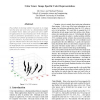CVPR
2004
IEEE
15 years 2 months ago
2004
IEEE
Model-based clustering of motion trajectories can be posed as the problem of learning an underlying mixture density function whose components correspond to motion classes with dif...
CVPR
2004
IEEE
15 years 2 months ago
2004
IEEE
We describe a method for simultaneously recovering the trajectory of a target and the external calibration parameters of non-overlapping cameras in a multi-camera system. Each cam...
CVPR
2004
IEEE
15 years 2 months ago
2004
IEEE
We propose methods for outlier handling and noise reduction using weighted local linear smoothing for a set of noisy points sampled from a nonlinear manifold. The methods can be u...
CVPR
2004
IEEE
15 years 2 months ago
2004
IEEE
Recovering the 3D coordinates of various joints of the human body from an image is a critical first step for several model-based human tracking and optical motion capture systems....
CVPR
2004
IEEE
15 years 2 months ago
2004
IEEE
Classifying high-dimensional numerical data is a very challenging problem. In high dimensional feature spaces, the performance of supervised learning methods suffer from the curse...
CVPR
2004
IEEE
15 years 2 months ago
2004
IEEE
Methods for expanding the dynamic range of digital photographs by combining images taken at different exposures have recently received a lot of attention. Current techniques assum...
CVPR
2004
IEEE
15 years 2 months ago
2004
IEEE
Active contour models are among the most popular PDE-based tools in computer vision. In this paper we present a new algorithm for the fast evolution of geodesic active contours an...
CVPR
2004
IEEE
15 years 2 months ago
2004
IEEE
Reconstructing 3D scenes with independently moving objects from uncalibrated monocular image sequences still poses serious challenges. One important problem is to find the relativ...
CVPR
2004
IEEE
15 years 2 months ago
2004
IEEE
The problem of deciding whether two pixels in an image have the same real world color is a fundamental problem in computer vision. Many color spaces are used in different applicat...
CVPR
2004
IEEE
15 years 2 months ago
2004
IEEE
In this paper, we introduce the notion of a programmable imaging system. Such an imaging system provides a human user or a vision system significant control over the radiometric a...





